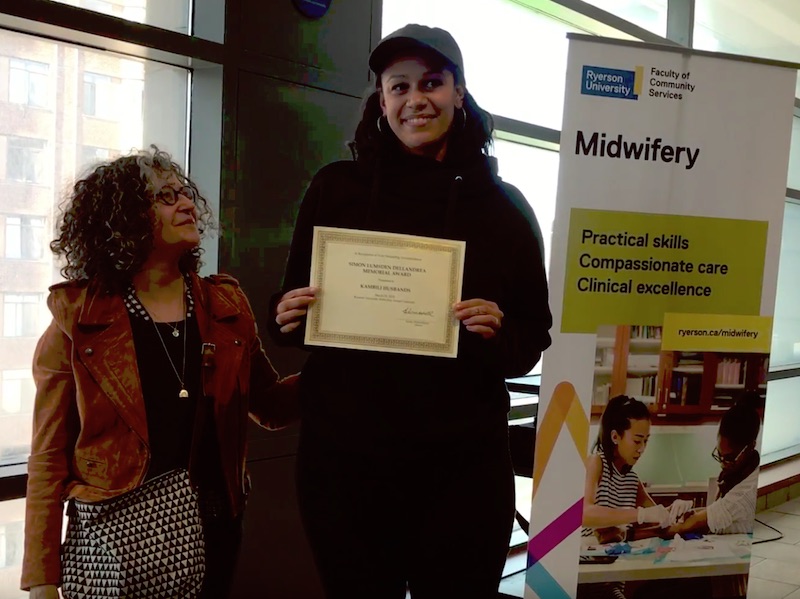Supporting each other

Photo: Research by fourth-year midwifery student Kambili Husbands (right), pictured here at the Midwifery Education Program student awards ceremony, led to the creation of a mentorship program and collective for BIPOC students.
When Kambili Husbands was in her first year of the Midwifery Education Program (MEP), she wanted to learn more about the experiences of other BIPOC (Black, Indigenous, People of Colour) students in the program.
“I thought we could do better to bring the voices of BIPOC people to the forefront and to celebrate the work that we’ve done and we’re doing to improve the profession,” she says.
After receiving a Partnership for Change: RBC Immigrant, Diversity, and Inclusion student grant, Husbands focused her research on BIPOC midwifery students and alumni who had immigrated to Canada themselves or whose parents had immigrated here. Midwifery professor Manavi Handa supervised the research project.
“Students were entering into the healthcare system as care providers for the first time, and having to navigate this already complex system of race,” Husbands says, in reference to the second half of the midwifery program, where students provide care for clients and their babies in a variety of clinical settings.
“The question became: How can Ryerson support students in that process?”
Husbands’ research suggested that a BIPOC mentorship program might help. “That’s the idea where senior-level students or midwives can work with entry-level students to support them to … feel heard, to feel like they belong there … or to find their voice as a BIPOC health care provider,” Husbands explains.
The MEP BIPOC Mentorship Program is now in its second year and currently facilitates 15 mentorship pairings between BIPOC students and midwives at various stages of their careers. The program gives mentors and mentees the option to match based on preferences for shared language, culture, heritage, geography or identity. It encourages mentorship pairs to communicate by social media, phone or in person on a weekly or monthly basis.
“From my experience as a mentor for the Midwives of Colour Committee, American College of Nurse Midwives and from the research, we see that a formal, evidence-based, respectful, individualized mentorship helps to increase the graduation rate of midwifery students of colour ... and promotes resiliency and professional skills that will prepare them for a long career in a stressful but valued profession,” says Karline Wilson-Mitchell, director of MEP and faculty lead for the mentorship program.
Husbands’ research also suggested that having a space within the program by and for BIPOC students might help to provide additional support. She went on to co-found the MEP BIPOC Student Collective in 2016, which provides a more informal space for social activities and mentorship.
“The collective is a group of BIPOC midwifery students that meet … to support one another through the program, to help each other … to mentor each other and to express our concerns and experiences,” says Maha Dostmohamed, a first-year midwifery student and co-chair of the collective.
“I think it’s one of my favourite parts of being in the program,” Dostmohamed says. “Having this group of people that I can count on, that I can go to for advice or help … it feels welcoming and it feels comfortable.”
In the future, the collective hopes to establish more formal mentorship opportunities between first-year students and upper-year students. This would build upon the existing mentorship program for students and midwives working in the field.
“BIPOC students are helping us to infuse diversity and inclusiveness throughout the program in ways that we’ve never thought of before,” says Wilson-Mitchell. “They feel more empowered to connect with faculty and share their ideas.”
“The research demonstrates the dire need to diversify our midwifery workforce if we are to promote health equity in our diverse population,” she adds. “BIPOC students are poised to add significantly to the scholarship of health equity research and respectful care delivery models.”
Many BIPOC students have shared with Wilson-Mitchell that the desire to serve their own communities is what motivated them to become midwives in the first place. Dostmohamed echoes that sentiment. “I do hope to serve my own community,” she says. “It’s a commonality we find in the BIPOC collective.”
“Our students want to be able to meet the needs of their very diverse clientele,” Wilson-Mitchell says. “They believe that understanding the history of midwifery of immigrants to this country will help them to do that.”
To that end, students are now collaborating with Wilson-Mitchell on the Canadian Midwives of Colour History Project, to be launched this spring. Using oral histories and video-storytelling, the project will create a new historical record informed by key learnings from senior immigrant community members.